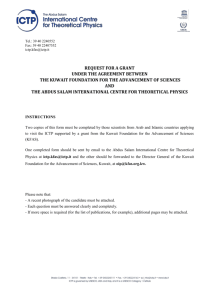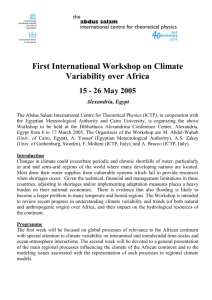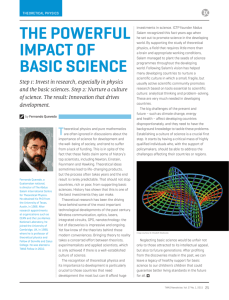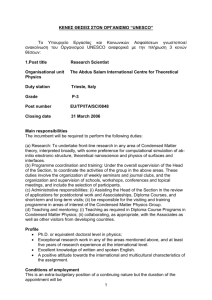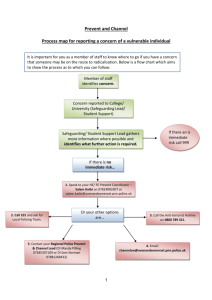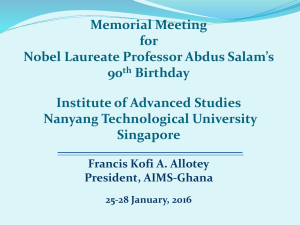Salam's Dream and Dynamic Changes in Chinese Condensed
advertisement
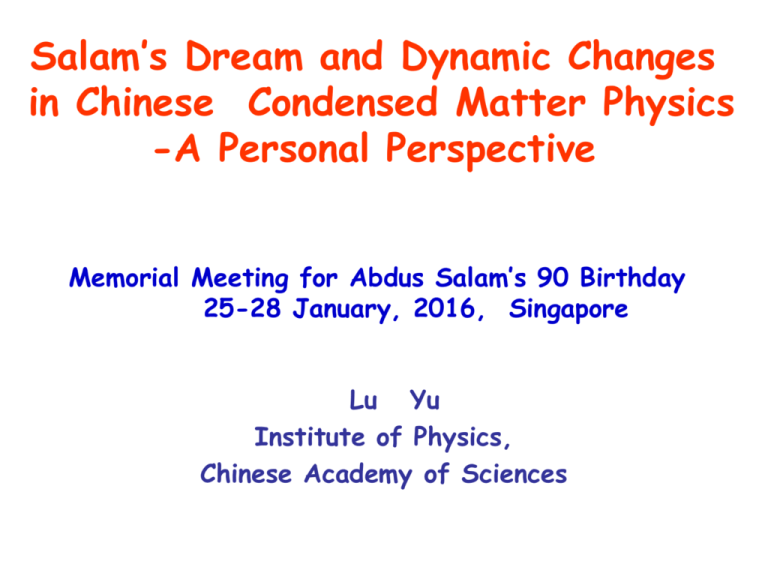
Salam’s Dream and Dynamic Changes in Chinese Condensed Matter Physics -A Personal Perspective Memorial Meeting for Abdus Salam’s 90 Birthday 25-28 January, 2016, Singapore Lu Yu Institute of Physics, Chinese Academy of Sciences “Scientific thought is the common heritage of all mankind.” -Abdus Salam In recent times, in this adventure of discovery on the frontier, the South has not been able to play a commensurate role...principally because of lack of opportunity. This, however, is not a situation which young men and women from the Third World will accept. They enviously, and deservedly, long to participate in this exciting adventure of scientific creation on equal terms. -Abdus Salam, TWAS Inauguration Meeting, 1985 Professor Abdus Salam was the ‘wise man’, mentor in my career. 1986-2002, at ICTP, 1986-96, directly under his supervision. Witness how he devoted his wisdom, energy, heart and soul to materialize the dream for the developing world. Witness how his dream is coming true, at least partially, in some parts of the South, including China, although the path is not straightforward, full of challenges, difficulties. Half-century ago modern CM physics was almost non-existent in China • Before 1949, the basis for science was very weak because of war…… • After 1949, “everything needs a boost”, a few welltrained physicists returned to China, like Kun Huang, Xide Xie, Kaijia Chen, Yinyuan Li, but because of the cold war, total isolation from the West Since beginning of 21 century Chinese CM physics entered the fast track: •A number of outstanding young physicists with cutting-edge output emerged in the World arena How did the quantal transition occur? Humble beginnings Interruption by ‘cultural revolution’ Opening-up and recovery 17 years at ICTP Current developments and some remarks Way out: ”learning from Soviet Union”, reform of education system, sending students for study, in less than 10 years, about 8000 young people got Diploma or “candidates” (Ph.D.) degrees I was fortunate to be one of them: 1956-1961 Kharkov State University, Diploma Thesis Supervisor: M.I. Kaganov Kharkov is the city where L.D. Landau created his school in physics. After his move to Moscow, I.M. Lifshitz took over the leadership L. Landau I.M. Lifshitz However, the good fortune did not last too long: China and SU broke up, no way to continue for Ph.D. More than that: No traveling for 17 years. To meet former supervisor only after 26 years! A New Start 1961 joined Institute of Physics, created in 1928 Rather poor material conditions, but encouraging environment, appointed as group leader at 24 Self- and mutual education to make up the lack of supervision. Intensive study and inspiring discussions. Group leader: Chunxian Chen who had chance to work for about two years as a diploma student in Prof. N. N. Bogoliubov’s group Fortunate outcome: 4 out of 5 key members later were elected to the membership of the Chinese Academy of Sciences Shigang CHEN Yuping HUO Bailin HAO Lu YU Cooper pairing of time-reversal states; k↑和-k↓ Anderson theorem: no dramatic effects of non-magnetic impurities Perturbative approach to treat time-reversal symmetry breaking - reduction of energy gap and transition temperature (Abrikosov, Gor’kov) Is it possible to form a bound state like in semiconductors? As a big exercise, bound state in superconductors with paramagnetic impurities: A self-consistent solution of the generalized Bogoliubov transformation ( Bogoliubov-de Gennes Eq) Also calculated additional EM absorption and tunneling current 1968 H. Shiba, 1969 A.I. Rusinov, made similar predictions 1981 Observed in tunneling, Prof. Buckel 1997 Direct observation by STM, A. Yazdani 1994 Los Alamos,impurity effects on D-wave superconductors- A. Balatsky A.Yazdani et al., Science 275,1767(1997) S.H.Ji et al, PRL 100,226801 (2008) p-wave superconductivity and Majorana fermions = + ( + ) A fermionic particle whose antiparticle is itself A p-wave superconductor is a natural host of MF Li Lv Superconducting … Fu & Kane, (PRL 2008): Pairing of helical electrons via proximity effect at s-wave superconductor-TI interface resembling spinless px+ipy-wave superconductivity Li Lv Zero biased peak Humble beginnings Interruption by ‘cultural revolution’ Opening-up and recovery 17 years at ICTP Current developments and some remarks 1969-1971 “May 7th” school 1971 experimental work on superconductivity 1972 “anatomize” “NOVA” minicomputer Second visit of C.N. Yang to China, meeting with Chou En-Lai, article in “Guangming Daily” on importance of fundamental research 1972 my colleague Bailin Hao attended the Annual Meeting of Canad. Assoc.of Phys. Heard talk by M.E. Fisher on Ken Wilson’s work We went to the library: Journals were not displayed, but received: Surprisingly finding the enormous progress on phase transition and critical phenomena Strong feeling of lagging behind Making up with anxiety: to study and share all important papers one-by-one During the process of learning: Calculation of the critical exponents by Yu Lu and Hao Bailin Skeleton Graph Expansion for Critical Exponents of Continuous Phase Transitions YU Lu HAO Bailin Institute of Physics, Chinese Academy of Sciences No abstract, even no title in English Skeleton graph expansion E. Brezin et al. , Phys. Lett. 44A, 227 (1973) Two pages of brief report, no derivations Another important event during ‘cultural revolution’- visit of a delegation from American Physical Society in 1975, as a reciprocal visit of Chinese Solid State Physics delegation to the US in March-April, 1975. “ The Solid State Physics delegation wished to make an in-depth study of major areas of solid state physics research and teaching in the People’s Republic of China.” –-from the exchange letter in arranging the visit. One-month visit: 4 Sept.- 2 Oct., 1975 10 eminent Solid State Physicists Charles Slichter Nicolaas Bloembergen Leroy Chang Ted Geballe Conyers Herring Ivar Giaever Bob Schrieffer John Bardeen John Gilman Bob Silsbee Contents 1 The roots of science in China today 2 Visits to research institutes and universities 3 Research in solid state physics 4 The new approach to science education 5 Communicating the fruits of research 6 Reflections on our visits National Academy of Sciences Press, Washington, 1976, 219 pages Appendices 1975年与 Bob Schrieffer 在物理所合影 Comments on our work: “Some theorists attached to the magnetism group of the Institute of Physics described to us some rather sophisticated and innovative work on critical exponents near continuous-phase transition points. This study used renormalization-group theory and diagrammatic analysis, methods similar to those used in the most advanced contemporary work in the West and in the Soviet Union … These studies were the most conspicuous exception we found to the general pattern of the Chinese solid state theorists’ preoccupation with classical or semi-classical phenomenology.” Humble beginnings Interruption by ‘cultural revolution’ Opening-up and recovery 17 years at ICTP Current developments and some remarks To attend the 17th Solvay Conference at Brussels, in 1978: “Order and Fluctuations in Equilibrium and NonEquilibrium Statistical Mechanics”, first scientific exchange after 17 years, to meet P.W. Anderson, L. Kadanoff, M.Fisher, and many others. 1979-1980 to visit B. Halperin ‘s group, to regain the feeling of front-line research. Bert jokingly called me “Senior postdoc” Visiting Bob Schrieffer at UC Santa Barbara, 1981 Humble beginnings Interruption by ‘cultural revolution’ Opening-up and recovery 17 years at ICTP Current developments and some remarks Prof. Abdus Salam Prof. Stig Lundqvist 1983 Lundqvist’s visit to China, invitation to ICTP, Chalmers U. and NORDITA. Second visit to ICTP as an associate Establishment of new staff position, first directly coming from developing countries Suggestion by Stig Lundqvist to take up this position Approval by Professor Abdus Salam Professor Salam’s letter dated 25 October, 1985 From Professor Salam’s letter: 2. We would like the Condensed Matter activities in developing countries to be enhanced through your presence here at the Centre. This will mean: (a) … one of the tasks is the responsibility for building up in developing countries the solid state communities where they do not exist… (b) Since Condensed Matter Physics is more concerned with development issues…… we would appreciate your keeping this activity very much in mind… 4. Finally, if I may humble say this, the continuation of the position… depends … on the success which is achieved in helping with the objectives in respect of enhancing studies and use of Condensed Matter Physics in developing countries set above. We all look forward to a second revolution in the Condensed Matter Activity in developing countries with your appointment and through your influence Profound respect and anxiety, at the same time ICTP-SISSA have played a crucial role in helping China to train young scientists and to integrate them to the World scientific community Most scientists in physics, mathematics and some applied scientists went out to the international arena through ICTP-SISSA Many senior scientists benefited a lot, like Hao Bailin, Su Zhaobin, Pu Fucho, Tao Ruibao, Zhu Banfeng, and many others A number of current leading figures have grownup from ICTP-SISSA training 5342 visitors, 193 associates, 41 TRIL fellows Under Professor Salam’s supervision the duties at ICTP were performed well, and Yu Lu was awarded the American Institute of Physics Tate Medal for International Leadership in Physics in recognition of four decades of landmark contributions in bringing together the world’s condensed matter physics community, the support of young scientists, the creation of important international conferences, and international statesmanship in theoretical physics. Professor Salam was awarded the same medal in 1978 Humble beginnings Interruption by ‘cultural revolution’ Opening-up and recovery 17 years at ICTP Current developments and some remarks Many years of concerted efforts have produced some visible results One example: Iron-based superconductors Many groups in China have made important contributions Dirac & Weyl Fermion Dirac equation (1928) 4x4 Prediction of positron Massive Dirac Fermion Weyl equation (1929) 2x2 Prediction of Weyl fermion H. Weyl, “Electron and gravitation,” Z. Phys. 56, 330 (1929) Massless Dirac Fermion: two Weyl Fermions with opposite topological charges “kiss”. H. Ding Rescue from condensed matter: quasiparticle • Low-energy excitations of interacting electrons in solid are often described as quasiparticles. • Quasiparticles can obey the same physical law as fundamental particles, e.g., quasiparticle in graphene is 2D massless Dirac fermion. Graphene Graphene band structure: 2D massless Dirac fermion H. Ding Dirac Semimetal with Band Inversion as “singularity point” of various topological states Normal OR Topological Insulator “3d graphene" mass term + 4-fold Breaking inversion symmetry Theory: Na3Bi & Cd3As2 ARPES: Z.K. Liu et al., Science 343, 864 (2014) - Noncentrosymmetri c nonmagnetic Weyl Semimetal + Z. Wang et al., PRB 85, 195320 (2012) Z. Wang et al., PRB 88, 125427 (2013) 2-fold Breaking time reversal symmetry - Magnetic Weyl Semimetal S. Borisenko et al., PRL 113, 027603 (2014) S.Y. Xu et al., Science 347, 294 (2015) H. Ding A proposed simple Weyl semimetal: TaAs Breaking inversion symmetry Nonmagnetic materials - easy to grow and measure with ARPES TaAs : 12 pairs of Weyl nodes in the bulk (8 W1, 4 W2) W1 W2 H.M. Weng et al., Phys. Rev. X 5, 011029 (2015) S. M. Huang et al., Nature Comm. (2015) H. Ding Properties of WSM Exotic properties Fermi arcs Chiral anomaly Negative magnetoresistance “magnetic monopole” Nonlocal transport Quantum anomalous Hall effect Unconventional superconductivity …… H. Ding 30 years ago, when TWAS was established the developing countries with 80% of world population were producing 5% of world scientific publications. R&D budget in developing countries-0.25% of GNP, while 2.5% in developed countries. In real money,2 vs 100 billion USD. In 2010 (according to UNESCO Report), scientific output from 7 developing countries-Argentina Brazil, China, India, Iran, Mexico and Turkey32%, with 10.6% from China alone (3%, 10 years back), being second worldwide, after USA only. Most importantly, quality not the number counts first Nature Index (2012-2014) Factors contributing to success: Sustainable government support:10-15 % annual growth rate in last 10 years Training and backflow of manpower: quite good coverage of key branches Investments in big facilities and instrumentation: Synchrotron, neutron, TEM, STM, optics, etc Consolidation of community: Forum on High Temperature superconductivity: 13 sessions Professor Salam’s dream partly comes true “We all look forward to a second revolution in the Condensed Matter activity in developing countries with your appointment and influence.” The ICTP-Asia Pacific in Beijing, China Prof. Bai Chunli has submitted a proposal of the Government of China to establish the International Centre for Theoretical Physics-Asia Pacific (ICTP-AP) at the University of the Chinese Academy of Sciences (UCAS) as a category 2 Center at the auspices of UNESCO This proposal has been approved by the UNESCO Executive Board at the 197th session on 15 October, 2015 It will follow the model of ICTP in Trieste, and will be contructed at the UCAS campus in Huairou, north of Beijing UNESCO Secretary General Irina Bokova’s letter to CAS President Bai Chunli About 50 Km from Beijing Center Thank you all!
